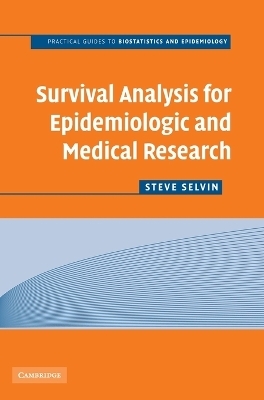
Survival Analysis for Epidemiologic and Medical Research
Seiten
2008
Cambridge University Press (Verlag)
978-0-521-89519-4 (ISBN)
Cambridge University Press (Verlag)
978-0-521-89519-4 (ISBN)
This practical guide for readers with a minimal background in statistics shows how to analyze and interpret epidemiologic and medical survival data with the help of modern computer systems. The author introduces key methods of survival analysis that are also central to statistical analysis in general.
This practical guide to survival data and its analysis for readers with a minimal background in statistics shows why the analytic methods work and how to effectively analyze and interpret epidemiologic and medical survival data with the help of modern computer systems. The introduction presents a review of a variety of statistical methods that are not only key elements of survival analysis but are also central to statistical analysis in general. Techniques such as statistical tests, transformations, confidence intervals, and analytic modeling are presented in the context of survival data but are, in fact, statistical tools that apply to understanding the analysis of many kinds of data. Similarly, discussions of such statistical concepts as bias, confounding, independence, and interaction are presented in the context of survival analysis and also are basic components of a broad range of applications. These topics make up essentially a 'second-year', one-semester biostatistics course in survival analysis concepts and techniques for non-statisticians.
This practical guide to survival data and its analysis for readers with a minimal background in statistics shows why the analytic methods work and how to effectively analyze and interpret epidemiologic and medical survival data with the help of modern computer systems. The introduction presents a review of a variety of statistical methods that are not only key elements of survival analysis but are also central to statistical analysis in general. Techniques such as statistical tests, transformations, confidence intervals, and analytic modeling are presented in the context of survival data but are, in fact, statistical tools that apply to understanding the analysis of many kinds of data. Similarly, discussions of such statistical concepts as bias, confounding, independence, and interaction are presented in the context of survival analysis and also are basic components of a broad range of applications. These topics make up essentially a 'second-year', one-semester biostatistics course in survival analysis concepts and techniques for non-statisticians.
Steve Selvin is Professor of Biostatistics and Epidemiology at the University of California, Berkeley. He has taught on the Berkeley campus for 35 years and has authored or co-authored more than 200 scientific articles in the areas of applied statistics and epidemiology. He has received two university teaching awards and is a member of the ASPH/Pfizer Public Health Academy of Distinguished Teachers.
1. Rates and their properties; 2. Life tables; 3. Two especially useful estimation tools; 4. Product-limit estimation; 5. Exponential survival time probability distribution; 6. Weibull survival time probability distribution; 7. Analysis of two-sample survival data; 8. General hazards model: parametric; 9. General hazards model: nonparametric.
| Erscheint lt. Verlag | 3.3.2008 |
|---|---|
| Reihe/Serie | Practical Guides to Biostatistics and Epidemiology |
| Zusatzinfo | Worked examples or Exercises; 79 Tables, unspecified |
| Verlagsort | Cambridge |
| Sprache | englisch |
| Maße | 180 x 254 mm |
| Gewicht | 660 g |
| Themenwelt | Mathematik / Informatik ► Mathematik |
| Studium ► Querschnittsbereiche ► Epidemiologie / Med. Biometrie | |
| ISBN-10 | 0-521-89519-7 / 0521895197 |
| ISBN-13 | 978-0-521-89519-4 / 9780521895194 |
| Zustand | Neuware |
| Haben Sie eine Frage zum Produkt? |
Mehr entdecken
aus dem Bereich
aus dem Bereich
ein überfälliges Gespräch zu einer Pandemie, die nicht die letzte …
Buch | Hardcover (2024)
Ullstein Buchverlage
CHF 34,95


